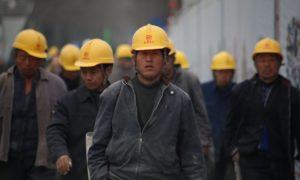Featured
Asia Takes the Lead in Global Development as Europe Approaches Recession
The forecasts for Europe are the most pessimistic in the face of a recession for Germany. Over the next two years, the engine of the world’s economic growth will be the developing countries of Asia. India’s economic growth is expected to be 6.6% in 2022, slowing by six-tenths in 2023 to 5.7%, before expanding again in 2024 to 6.9%, regaining pre-pandemic figures and becoming the fastest-growing OECD country.

The economic forecast map of the Organization for Economic Cooperation and Development (OECD) draws a map of a two-speed world. While the developing countries of Asia are waiting for their great leap forward, Europe is preparing for a cold winter and the worst energy crisis since 1970, which will cause its great locomotive, Germany, to fall into recession.
Overall, the world Gross Domestic Product (GDP) will increase by 2.2% next year, a slowdown from the Paris-based organization’s forecast growth of 3.3% for this year. While admitting a slowdown in the global economy due largely to the war in Ukraine, the OECD rules out a recession.
Read more on the subject and find the most important economic news of the day with the born2Invest mobile app.
Asia takes off with India leading the way
Over the next two years, the engine of the world’s economic growth will be the developing countries of Asia. India’s economic growth is expected to be 6.6% in 2022, slowing by six-tenths in 2023 to 5.7%, before expanding again in 2024 to 6.9%, regaining pre-pandemic figures and becoming the fastest-growing OECD country. For next year, inflation will remain above 6% in the first quarter but will begin to decline as the year progresses.
Another country that will grow at a good pace in the coming years will be Indonesia, due to high commodity export rates. GDP growth will remain close to 5% in 2023 and 2024, while inflation will not exceed 4%.
However, Asia’s major advanced economies will not grow at the same rate as emerging countries. In Japan, rising energy prices have weighed on household incomes, depressed business confidence and investment, and dampened exports. The OECD forecasts that the Japanese GDP will grow by 1.8% in 2023, two-tenths higher than in 2022, before slumping to 0.9% in 2024.
In 2023, South Korea’s GDP growth will moderate to 2%, seven-tenths less than in 2022, and will continue this trend until 2024. The downgrade in economic forecasts is also conditioned by weak external demand, as well as high inflation, stagnating incomes, and a housing market in crisis.
Weak growth in the OECD countries will also be rewarded by the resumption of growth in China. The Asian giant has been living since the start of the pandemic suspended in uncertainty by Covid Zero policies and the real estate crisis, but public investment in 2023 will focus on reviving investment in infrastructure and reversing the moderation of its economy. With growth forecast at 3.3% in 2022, China’s economy will rebound to 4.6% in 2023 and moderate again to 4.1% in 2024, with inflation at lows.
Europe awaits its economic winter
The forecasts for Europe are the most pessimistic in the face of a recession for Germany. For the German economy, the OECD forecasts recession in 2023, with setbacks of 0.3%, and recovery in 2024, with an upturn of 1.5%.
Another country on the continent to which the OECD predicts a year of contraction is the United Kingdom, with a 0.4% decline next year. This stagnation will last until 2024, when it will register a slight increase of 0.2%.
Most of the major economies are sharply slowing their growth as a result of the war in Ukraine and weak external demand, which will continue to decline. In addition, high energy and food prices or supply chain disruptions have lowered eurozone growth in 2023 to 0.5%, almost three percentage points lower than in 2022.
In the next two years, demand will grow at a moderate pace and inflation will decelerate, but high energy prices and rising retail prices will not allow GDP to pick up in 2024, which will grow by 1.4% in Europe.
Above the eurozone average, Spain will grow by 1.3% in 2023, a forecast that is two-tenths of a percentage point lower than that predicted in September by the same institution. For its part, France will expand its GDP by 0.6% in 2023 and 1.2% in 2024, just above Italy, with 0.2% in 2023 and 1% in 2024.
North America slows its growth
In the United States, the tightening of monetary policy by the Fed, which has raised interest rates six times this year, has weakened investment, especially in the real estate sector. At the same time, inflation has been relentless and real incomes have fallen, while export activity has lost steam. In 2022, GDP is expected to slow to 1.8%, to fall to 0.5% in 2023, before rising again to 1% in 2024.
Canada’s economy will follow a similar path to that of the United States. The OECD forecasts that the country will return to inflation close to 2% in 2024, following the impact of its strong monetary policy, which will close the year with interest rates at 4.5%, while Canadian GDP will close the year with 1% growth, verge on recession in 2023 and return to positive territory in 2024.
Latin America hastens its spring
In Latin America, the main economies have performed better than initially expected, especially in food and energy-exporting countries. However, the OECD expects the upturn to lose steam over the next two years due to the commodity price boom and tighter financial conditions. In addition, inflation in Latin America is at record highs, despite rising interest rates at many central banks.
In Brazil, the continent’s largest economy, slowing exports, tight credit conditions, and a less expansionary fiscal policy will slow growth next year and improve slightly in 2024.
__
(Featured image by rupixen.com via Unsplash)
DISCLAIMER: This article was written by a third party contributor and does not reflect the opinion of Born2Invest, its management, staff or its associates. Please review our disclaimer for more information.
This article may include forward-looking statements. These forward-looking statements generally are identified by the words “believe,” “project,” “estimate,” “become,” “plan,” “will,” and similar expressions. These forward-looking statements involve known and unknown risks as well as uncertainties, including those discussed in the following cautionary statements and elsewhere in this article and on this site. Although the Company may believe that its expectations are based on reasonable assumptions, the actual results that the Company may achieve may differ materially from any forward-looking statements, which reflect the opinions of the management of the Company only as of the date hereof. Additionally, please make sure to read these important disclosures.
First published in PlantaDoce, a third-party contributor translated and adapted the article from the original. In case of discrepancy, the original will prevail.
Although we made reasonable efforts to provide accurate translations, some parts may be incorrect. Born2Invest assumes no responsibility for errors, omissions or ambiguities in the translations provided on this website. Any person or entity relying on translated content does so at their own risk. Born2Invest is not responsible for losses caused by such reliance on the accuracy or reliability of translated information. If you wish to report an error or inaccuracy in the translation, we encourage you to contact us.

-

 Africa7 days ago
Africa7 days agoMorocco’s Wheat Dependency Persists Despite Improved Harvest
-

 Crypto2 weeks ago
Crypto2 weeks agoBrazil’s Crypto Boom Threatened by Surprise Tax Proposal
-

 Biotech2 days ago
Biotech2 days agoEcnoglutide Shows Promise as Next-Generation Obesity Treatment
-

 Markets1 week ago
Markets1 week agoCocoa Prices Drop Amid Speculative Selling and West African Supply Concerns























